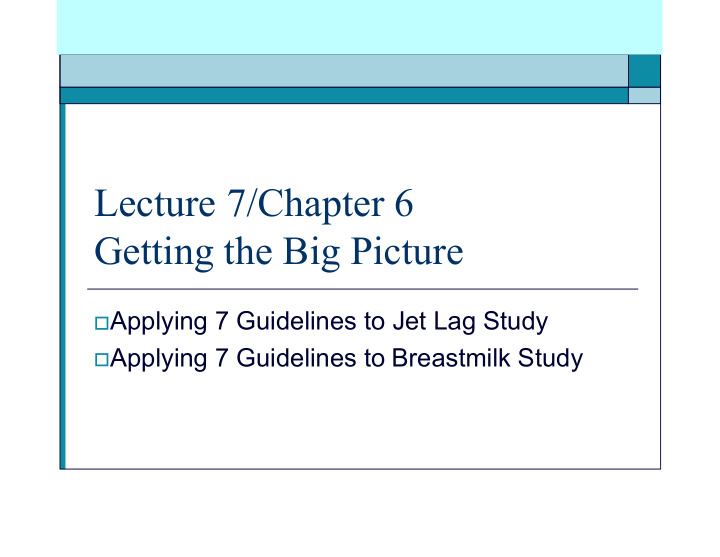



Lecture 7/Chapter 6 Getting the Big Picture Applying 7 Guidelines to Jet Lag Study Applying 7 Guidelines to Breastmilk Study
Seven Guidelines for Systematic Evaluation Step 1: Determine if study was sample survey, experiment, obs study, census, or anecdotes. Step 2: Consider 7 Critical Components (details). Step 3: Check for “Difficulties and Disasters” (sampling p. 69, exp. p. 90, obs. studies p. 96) Step 4: Is info complete? If not, find original? Step 5: Do results make sense? Step 6: Are alternative explanations possible? Step 7: Do results affect your attitude/lifestyle?
Prepared for step-by-step discussion of how 7 Guidelines apply to jet lag & breastfeeding studies; note 7 Critical Components for step 2: Source of research and funding 1. Researchers who had contact w. participants 2. Individuals studied, how they were selected 3. Variables studied [measurements, questions] 4. Setting (time, place) 5. Confounding variables [differences besides 6. factor of interest] if causal relationship is claimed Extent or size of claimed effects/differences 7.
Example: Jet Lag & 7 Guidelines Background : Jet lag? Just light up your knee. Question: How does each guideline apply? Response: Step 1 (study design): Step 2 (7 Components): #1 source/funding: #2 researchers having contact w. participants: #3 individuals/how selected:
Example: Jet Lag & 7 Guidelines Response: Step 2 (7 Components) continued: #4 variables: explan: response: #5 setting: #6 extraneous differences/confounding variables: #7 extent or size of effect:
Example: Jet Lag & 7 Guidelines Response: Step 3 Difficulties? (Exp. p. 90) 1. Confounding variables? 2. Interacting variables? 3. Placebo, Hawthorne, experimenter effects? Did subjects know if they were getting light? Would Hawthorne effect lead to different responses for treatment & control? Are responses (temp, melatonin) subjective (subject to influence or interpretation by researchers)? 4. Lack of realism?
Example: Jet Lag & 7 Guidelines Response: Step 4 Information complete? Step 5 Do results make sense? Step 6 Alternative explanation? Step 7 Results’ impact on you?
Example: Breast Milk Benefit & Guidelines Background : Breast Milk Benefit Question: How does each guideline apply? Response: Step 1 (study design): Step 2 (7 Components) #1 source/funding: #2 researchers having contact w. participants: #3 individuals/how selected:
Example: Breast Milk & Guidelines Response: Step 2 (7 Components) continued #4 variables: explanatory-- response-- #5 setting: #6 confounding variables: #7 extent or size of effect:
Example: Breast Milk & Guidelines Response: Step 3 Difficulties? (Obs. p. 96) Confounding variables? 1. Sample non-representative? 2. Time as confounder? 3. Step 4 Information complete? Step 5 Do results make sense? Step 6 Alternative explanation? Step 7 Results’ impact on you?
Example: Breast Milk & Guidelines Note: a subsequent study linked breastfeeding and intelligence. Bottle fed and smart is the reaction of an indignant mother’s letter to the editor. Extra credit (Max. 5 pts.) From the Internet or a newspaper or magazine, find an article about a statistical study. Write several paragraphs detailing the 7 Guidelines, including a paragraph on Step 2: the 7 Critical Components.
FDA CONSIDERS ADDING NUTRIENT TO INFANT FORMULA A fat found in breast milk that appears vital for newborns' brain and eye development is at the center of a fierce debate: Should the government add this nutrient to the nation's infant formulas? …Supporters say premature infants especially need the fat, arguing it would make formula more like mothers' milk. They cite studies that show breast-fed babies seem slightly smarter than formula-fed infants and speculate DHA could help bottle-fed babies catch up… BABY FORMULA ENHANCED Some brands of infant formula should become more like breast milk as early as year’s end. The government has cleared the way for companies to begin enhancing formula with two fatty acids---found naturally in breast milk---that are important for brain and vision development. Some studies show that infants fed nutrient-enriched formula score higher on baby IQ scales than babies fed today’s formulas.
Recommend
More recommend